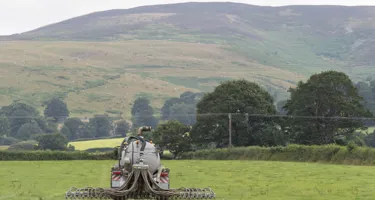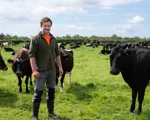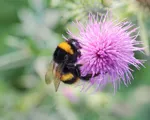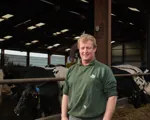
Using data to produce milk in the most sustainable way we can
At Arla, we believe we all have to play our part in addressing climate change and the challenges this brings. That means reducing the carbon footprint of dairy as quickly and as efficiently as possible. But you can’t manage what you don’t measure, so, Arla’s farmers have been taking part in FarmAhead™ Check. It’s an individual carbon footprint offered to every Arla farmer and independently verified by an external consultant.
FarmAhead™ Check help's our farmers identify the best areas to take steps to reduce their carbon footprint on their farm, but when collated together, this data from almost 2,000 UK dairy farms shares a picture of what’s really happening across Arla UK farms to further reduce the emissions involved in making some of Britain’s best loved dairy products. The data shows Arla farmers already produce milk with around half the global average. This shows that Arla farmers are already well on their way to becoming more sustainable. The data will help our farmers go even further, helping Arla meet its science based targets of a 30% reduction per kg of milk by 2030, and carbon net zero by 2050. Because we believe it’s important to share action to help increase action, the findings have been published in a report called “A sustainable future for British Dairy”.
The report shows Arla’s raw milk emissions come from six key areas on farm:
- cow digestion (46%)
- cow feed (where and how it is produced) (37%)
- manure handling (9%)
- energy production and usage (5%)
- emissions from peat soils (1%)
- all other areas grouped together (2%).
Almost all of Arla’s 2,400 UK farmer owners are taking steps to reduce their emissions on farm to keep milk as part of a sustainable diet. We know that to feed a growing population, we have to produce natural, nutritious and affordable food that is made in the most sustainable way. Dairy can and should be part of a sustainable diet and our FarmAhead™ Check and report are major steps forward in demonstrating just how much action is already underway across Arla farms as we move towards carbon net zero dairy production. If we want more biodiversity, fewer emissions through natural processes and a reduced reliance on ultra-processed foods, then the only answer is to support British farmers, who already have many of the answers, but not always the financial resources to implement them.

Some of the actions taking place on farms include
- Most farmers are looking at ways to balance what their cows eat to ensure the right levels of protein and fibre … for example, too much protein can cause extra burps!
- 79% of Arla’s UK farm land is used to grow grass which also helps take carbon out of the atmosphere
- 53% of UK farmers are using precision slurry spreading techniques, which can help reduce air born emissions of ammonia by between 30% and 90%
- 19 farms are using anaerobic digestion which reduces the release of emissions from slurry (cow poo) while also creating renewable energy
- 27% of Arla farmers already producing green energy from wind or solar
- We’ve lots of trials and innovations to look at ways to reduce emissions going forwards. Some of these could prove game changing for dairy emissions in the years to come.
Find out more in our report: Download here







































